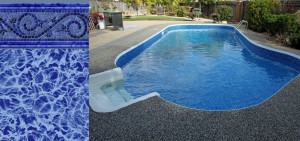MYTH #1 – Salt Systems are maintenance free

MYTH #2: Salt Water Pools are chlorine free
I think this myth comes from the pool builders (who love to sell and install salt systems), who tend to ask it this way – “…will you be wanting a saltwater pool, or a chlorine pool?”, as if they were mutually exclusive. A saltwater pool is a chlorine pool. The chlorine made with a salt chlorinator is exactly the same (hypochlorous acid), as the chlorine produced from a tablet, or shock, or bleach. Saltwater pools also do not use less chlorine than a pool treated with tablets/shock. The same amount of disinfectant is needed; chlorine demand does not change, just because one adds salt to the pool.
MYTH #3: Salt Systems save Money
If you’re lucky, the Total Cost of Ownership (TCO) for both chlorine delivery systems are almost equal. Over 5 or 10 years time, the aggregate costs of using tablets and shock, or using a salt chlorine generator are pretty close in cost. Adding in the electricity used, and possible longer pump run times (salt cells only work when the pump is running), and the overall cost for pool owners is almost always cheaper with tablet chlorine and occasional shock treatments.
If you’re unlucky however, and you have problems with the circuit board or sensors, or if the salt cell lifespan is shorter than expected, the cost of using a saltwater system could be much higher than using chlorine tablets. Salt cell lifespan can be reduced by using it in cool water 60-70°, or from poor water balance. Systems that are undersized for the pool become easily overworked, as do pools with regular algae or high debris levels. Not cleaning the cell properly or regularly enough will also shorten the lifespan.
MYTH #4: You’ll never need to buy, store or handle Chlorine again
Remember that salt systems only create chlorine when the system is working, so if you have salt cell, sensor or controller problems, no chlorine is created. Also, if you have pump, filter or plumbing problems, and are unable to run the filter pump, no chlorine is created. It may be wise to keep some chlorine on hand for situations like these, as they arrive unexpectedly.
Secondly, although some saltwater systems have a shock feature, they are slow to react and using the feature puts a strain on the salt cell, operating at 100%. Many pool owners with salt systems may prefer to shock with granular chlorine, and it may be necessary, especially for spring pool openings or for algae removal, or decontamination of the pool. For plaster pools, granular chlorine is also a great pool stain remover.
MYTH #5: Your pool will use less Chemicals
This myth is easy to sell to the uninitiated, but you my dear reader are smarter than that! As established earlier, a saltwater system is a chlorine delivery system, and you won’t need less chlorine using salt vs. chlorine tablets. You also won’t need less other chemicals – pH, alkalinity or calcium adjusters for water balance, no change there. You still need to use cyanuric acid, or chlorine stabilizer. In fact, many manufacturers recommend a high-range level of 60-80 ppm of cyanuric acid, in an effort to reduce salt cell workload on sunny days. And, a pool that needs to use algaecide, clarifier, enzymes or a metal remover – will still need to use them, no matter how the chlorine is introduced into the pool.
MYTH #6: Saltwater pools are eco-friendly
This final myth has a small element of truth, but it’s probably different than what you were thinking. Salt systems are still chlorine pools, and they also contain salt. Pumped or leeched into local streams and estuaries, high levels of chlorine and/or salt can damage local ecosystems. But salt systems redeem themselves due to the fact that when you make your own chlorine, you don’t have to buy so much chlorine. And when you buy chlorine you probably drove down to pick it up, or had a delivery from a noisy brown truck, belching exhaust. Not to mention all of the other transportation that occurred to move the chlorine from the tableting facility, to the distributor and to the retailer.
With a salt system, you don’t need to buy (much) chlorine, and this reduces factory chlorine production, which on a large factory scale, is not a very eco-friendly process. When you don’t buy so much chlorine, year after year, and when millions of other pool owners do the same thing, chlorine production slows down.
